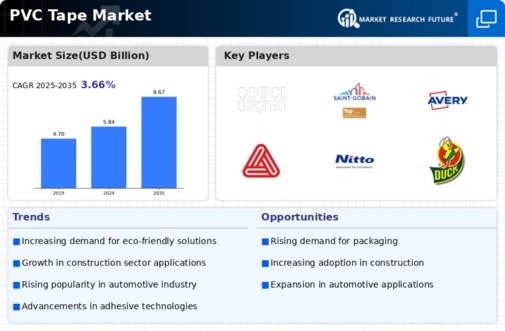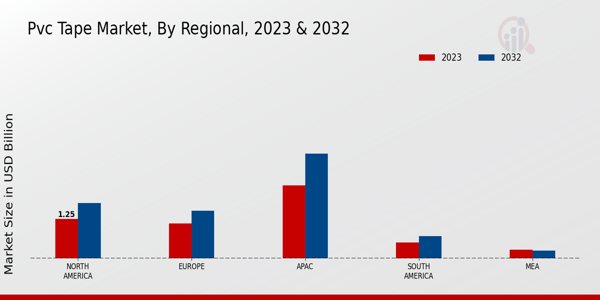Market Growth Projections
The Global PVC Tape Market Industry is poised for substantial growth, with projections indicating a market size of 5.84 USD Billion in 2024 and an anticipated increase to 8.67 USD Billion by 2035. This growth trajectory suggests a compound annual growth rate (CAGR) of 3.65% from 2025 to 2035. Such figures reflect the increasing adoption of PVC tape across various sectors, driven by its versatility and performance characteristics. As industries continue to recognize the advantages of PVC tape, the market is likely to expand, presenting opportunities for manufacturers and stakeholders alike.
Technological Advancements
Technological advancements play a crucial role in shaping the Global PVC Tape Market Industry. Innovations in manufacturing processes enhance the quality and performance of PVC tapes, making them more appealing to consumers. For instance, the introduction of eco-friendly formulations and improved adhesive properties cater to the increasing demand for sustainable products. These advancements not only boost product efficacy but also contribute to market growth. As manufacturers invest in research and development, the market is likely to witness an influx of high-performance PVC tapes, thereby expanding its application scope across various industries.
Expanding Application Scope
The expanding application scope of PVC tape across diverse industries significantly contributes to the growth of the Global PVC Tape Market Industry. Beyond traditional uses in construction and electrical sectors, PVC tape finds applications in packaging, automotive, and even healthcare. This versatility is a key factor driving market expansion, as businesses increasingly recognize the benefits of using PVC tape for various purposes. The projected CAGR of 3.65% from 2025 to 2035 underscores the potential for sustained growth as new applications are discovered and existing ones are optimized, further solidifying PVC tape's position in the market.
Growing Automotive Industry
The automotive industry significantly influences the Global PVC Tape Market Industry, as manufacturers increasingly utilize PVC tape for various applications, including wiring harnesses and interior trim. The growing trend towards lightweight materials in vehicle production aligns with the properties of PVC tape, which offers both strength and flexibility. As the automotive sector continues to evolve, the demand for PVC tape is expected to rise, contributing to the market's projected growth. By 2035, the market is forecasted to reach 8.67 USD Billion, indicating a robust expansion driven by the automotive industry's ongoing transformation.
Rising Demand in Construction Sector
The Global PVC Tape Market Industry experiences a notable surge in demand driven by the construction sector. As urbanization accelerates globally, the need for efficient sealing and insulation solutions becomes paramount. PVC tape, known for its durability and versatility, is increasingly utilized in various applications, including electrical insulation and surface protection. In 2024, the market is projected to reach 5.84 USD Billion, reflecting the growing reliance on PVC tape in construction projects. This trend is expected to continue, with the market anticipated to expand further as infrastructure development initiatives gain momentum, particularly in emerging economies.
Increased Awareness of Safety Standards
Increased awareness of safety standards and regulations is a driving force behind the Global PVC Tape Market Industry. Industries such as electrical, construction, and manufacturing are increasingly adopting PVC tape to comply with safety requirements. The tape's insulating properties and resistance to environmental factors make it an ideal choice for ensuring safety in various applications. As regulatory bodies enforce stricter safety measures, the demand for reliable and high-quality PVC tape is likely to grow. This trend not only enhances market potential but also encourages manufacturers to innovate and improve product offerings to meet evolving safety standards.












